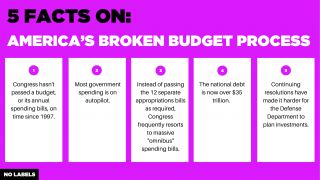America's budget process is in a state of disrepair, with Congress consistently failing to fund the government on time or manage the nation's finances efficiently. This dysfunction creates ripple effects throughout the economy and government operations.
Here are Five Facts on America’s broken budget process.
- Congress hasn't passed a budget, or its annual spending bills, on time since 1997.
Despite being required by law to pass 12 appropriations bills each year, Congress has failed to meet the September 30 deadline every year since 1997. When Congress can't agree on funding levels for the government, it relies on temporary "continuing resolutions" (CRs) to keep the government running. These stopgap measures prevent shutdowns but don't allow for meaningful fiscal planning, perpetuating a cycle of inefficiency.
- Most government spending is on autopilot.
Nearly three-quarters of federal spending is classified as "mandatory spending," covering programs like Social Security, Medicare, and Medicaid. This spending is automatically authorized by existing laws and doesn't go through the annual budget process. Congress only debates "discretionary spending," which represents a shrinking share of the overall budget, limiting flexibility in addressing important priorities ranging from scientific research, funding for our military, and early childhood nutrition programs.
- Instead of passing the 12 separate appropriations bills as required, Congress frequently resorts to massive "omnibus" spending bills.
Omnibus bills are when all government funding is bundled into a single piece of legislation. Since 2007, 16 of the last 18 fiscal years have relied at least in part on these bills. This practice reduces transparency, as individual programs are rarely debated in detail, forcing lawmakers to vote on large, unwieldy packages without thorough scrutiny.
- The national debt is now over $35 trillion.
The U.S. national debt has reached an unprecedented $35 trillion, and it continues to grow by about $1 trillion every three months. Our national debt is now 1.2 times the size of our total economic output, higher than all but three countries of the OECD, a group of 38 developed countries. For the first time in history, the country is spending more on interest payments for this debt than on national defense. This growing burden jeopardizes future economic stability and limits investments in essential sectors like education, healthcare, and infrastructure.
- Continuing resolutions have made it harder for the Defense Department to plan investments.
CRs create uncertainty for government agencies, especially in areas like national defense. The Department of Defense has highlighted how short-term funding agreements disrupt long-term planning and procurement, leading to shortages in critical supplies, such as missiles and other munitions. This instability weakens America's military readiness at a time when global threats are increasing.
Read Full Article »




